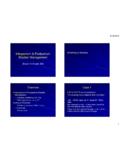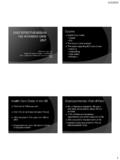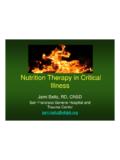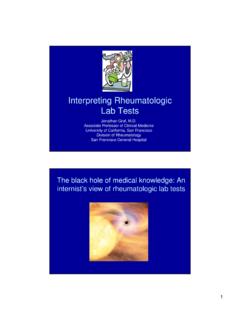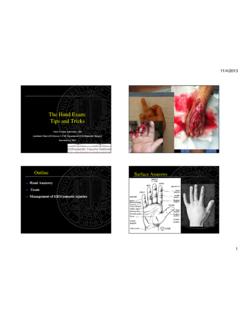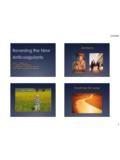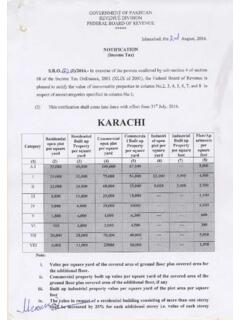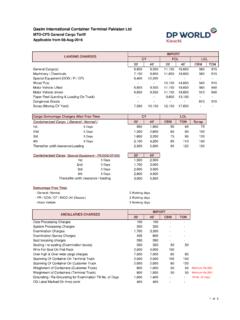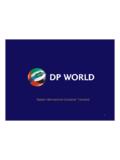Transcription of Choosing the Right Test - UCSF CME
1 5/28/20131 Choosing the Right Cardiac TestAtif qasim , , of California, San FranciscoDisclosures: None2013 Outline Focus on Choosing the optimal tests for coronary disease evaluation Overview of stress testing, imaging options and how tests are performed Instructive case scenarios with discussion5/28/20132 Test the AudienceWhich one of the following is true regarding stress testing? A. All patients who can exercise should have an exercise stress test (with/without imaging as appropriate). B. Patients undergoing conventional SPECT nuclear stress testing need to be able to lie flat. C. Beta blockers do not need to be stopped prior to a Dobutamine stress test.
2 D. Patients with COPD cannot have a vasodilator stress test. To Stress or not to Stress A paradigm shift has occurred for management of most stable CAD with medical therapy first rather than routine PCI. Significant cost and harm is associated with unnecessary testing, false positives, and additional procedures. Information from stress testing should be meaningful to direct Indications for Stress Testing For diagnosis and risk stratification in those with suspected CAD, or known CAD with a change in clinical status. Assess location and degree of ischemia in those with known CAD for the purposes of revascularization.
3 Determine if medical therapy and/or revascularization therapy is adequate for CAD. Evaluate severity and symptoms of valvular or congenital heart disease or evaluate arrhythmic therapy (non CAD related).Contraindications QuestionWhich of the follow is not an absolute contraindication to stress testing? A. Acute myocarditisB. Decompensated heart failureC. Acute MID. Severe uncontrolled hypertensionE. Symptomatic severe aortic stenosis5/28/20134 ContraindicationsAbsolute Acute MI within 2 days, or active unstable angina Symptomatic severe aortic stenosis Decompensated heart failure Aortic dissection Acute myocarditis or pericarditis Uncontrolled arrhythmias Acute PERelative Left main disease Severe uncontrolled hypertension Hypertrophic obstructive cardiomyopathy High degree AV blockHow does stress testing work?
4 Different tests interrogate different portions of this ischemic cascade. Each method employs a stressor and a detector. 5/28/20135 Mix and MatchStressors Exercise Treadmill Supine bike Vasodilator Adenosine Dipyridamole Regadenoson DobutamineDetectors EKG (used for all tests ) Echocardiography Radionuclide imaging Thallium 201, Technetium99M PET MRIE xercise on Treadmill Need to get to 85% max predicted HR (220 age), for an optimal test Usual Bruce Protocol starts at at a 10% grade and increases in speed and grade every 3 minutes. Test may be stopped early for significant chest pain, severe hypertensive or hypotensive response, marked ST changes, or arrhythmia.
5 5/28/20136 Exercise on Supine Bike Allows for echo imaging in real time during different phases of exercise Graded protocol with increase in workload every 3 minutes Good for valvular disease assessment in those who are functional, but cannot use the treadmill Pharmacologic Stressors Vasodilators Increases coronary blood flow 3 to 5 fold in normal arteries Diseased arteries do not augment flow well Effects can be reversed with aminophyllineafter radiotracer injection Contraindicated with active bronchospasm, high grade AV block, & significant hypotension Adenosine A2A (coronary vasodilation), A1 (AV delay), A2B, A3, A4 (bronchospasm) Short half life Dipyridamole(Persantine) Blocks re uptake of adenosine Longer half life Regadenoson Selective A2A agonist Shorter half life than Dipyridamole 5/28/20137 Pharmacologic Stressors Dobutamine Infusion protocol is with escalating doses of dobutamine in 3 min increments Goal to get to target HR of 85% max predicted Atropine (vagolytic) and hand/leg exercises are also used to augment heart rate Positive inotrope and chronotrope ( 1) Also some vasodilation properties ( 2)
6 Contraindicated in those with arrhythmias, significant hypertension, and marked LV outflow obstructionDetectors EKG Consistent horizontal or downsloping ST depressions in contiguous leads is positive ST depressions do not localize diseased vessel Not always a binary yes/no outcome. Can have equivocal/non diagnostic resultsACC/AHA Guidelines 20015/28/20138 Question EKGIn which of the following is treadmill EKG only ( no imaging) stress testing still appropriate?A. Left Bundle Branch BlockB. LVH with repolarization abnormalityC. WPWD. Ventricular pacingE. Digoxin useF. Right Bundle Branch BlockWhen should you consider imaging?
7 Baseline EKG is abnormal or uninterpretablefor ischemia Known CAD or prior revascularization with change in clinical symptoms (localize ischemia) Another question to be assessed (LV function, viability, hemodynamic significance of valvular disease, changes in PASP with exercise)5/28/20139 Nuclear Scanner Patient emits radioactivity which is detected by one or more cameras. Cameras rotate slowly around the patient to generate a 3D image of the heart. Patient must lie flat up to 20 30 min and not move. Artifact can occur from motion, and tissue ImagesNormal StressAbnormal StressStress RestRestRestStress Stress 5/28/201310 Echo imagingOther Considerations Radiation Dosage Cost Treadmill EKG< Stress echo < Cardiac CT Angio< SPECT < Coronary Angiogram Special patient populations (CT surgery, post transplant, obese, etc) Local expertiseSource.
8 X ray (for comparison) Angiogram7mSv (~15 if intervention done)Cardiac CT Angiography10 16mSvNuclear Stress Tc 9911mSvNuclear Stress Thallium17mSv5/28/201311Te s tP r o sC o n sExercise EKGCost effective No radiationPrognostic information from exerciseFalse positivesDoesn t localize ischemiaLess sensitive/specificVasodilator with SPECTEasy to administerGood for those with arrhythmias or hypertension RadiationMust lie flat/stay still Balanced ischemia possibleAttenuation artifactsExercise or Dobutaminewith EchoNo radiationHeart function, structure, valves, diastology ,PASP also assessedBaseline wall motion makes interpretation harderPoorer image quality in obeseVasodilator with PETH igher resolution, less artifactUseful in those who are obeseViability when FDG usedQuicker nuclear based studyRadiationShort half life of radiotracer limits stressor modalities Vasodilatorwith MRIH eart anatomy, structure, function, infarct size , location, viability all can be assessedNeed expertise, timeBreath holding, lie flat & still Regular HR idealViability Studies Use in those with known CAD, prior or recent infarct.
9 LV dysfunction To see if revascularization is reasonable to improve LV function Several options Dobutamine Echo Rest redistribution thallium PET/CT look for FDG uptake MRI look for extent of delayed enhancement5/28/201312 When to Consider Cardiac Cath High risk unstable angina A high pretest probability of CAD Positive stress test with large burden of reversible ischemia Failure of medical management for CAD Concern for an ischemic cardiomyopathy Preoperative assessment for cardiac valve surgery or high risk transplantation surgeryWhen to consider a Cardiac CT Acute chest pain with low probability of disease (ER setting) When there is a non diagnostic stress or when clinical findings and stress tests results are incongruous When a coronary anomaly is suspected To assess bypass graft patency or if there is a question about graft anatomy When traditional stress tests cannot be performed Limited use if there is renal insufficiency, tachycardia, arrhythmia, or too much coronary artery calcium5/28/201313 Case 1 A 60 yr old male with diabetes, hypertension, and COPD on home oxygen and theophylline who has chest pain.
10 He has severe chronic back pain and cannot lie flat. Which stress test is most appropriate?A. Exercise EKGB. Exercise stress echoC. Exercise nuclear D. Dobutamine stress echoE. Dobutamine nuclearF. Vasodilator nuclear G. Curbside the cardiologistCase 2A 62 yr old man with hypertension, hypercholesterolemia and atypical chest pain, that sometimes happens during exercise, but also at rest. He has known chronic Left Bundle Branch stress test is most appropriate?A. Exercise EKGB. Exercise stress echoC. Exercise nuclear D. Dobutamine stress echoE. Dobutamine nuclearF. Vasodilator nuclear G. Curbside the cardiologist5/28/201314 Case 3A 45 yr old female with diabetes, on dialysis and s/p BKA, admitted with chest pain, and ruled out for MI by EKG and cardiac stress test is most appropriate?
